Speech The Outlook for Dwelling Investment
Housing is important to all of us as a place to live. Housing construction has traditionally been one of the most cyclical parts of the economy. It tends to share this cycle with housing renovation activity and housing turnover. Given the important influences this housing cycle can also have on other parts of the economy, such as consumer spending on durable goods, it is easy to see why we pay so much attention to housing as an important driver of economic activity.
It is notable then that, for the past decade or so, the rate of housing construction has not been particularly cyclical, and has been at a low level. Indeed, some indicators suggest that supply has not kept up with demand. There are tentative signs, however, that dwelling investment (that is, investment in housing) will pick up which would, in part, offset the smaller contribution to growth that we expect from resource investment in the coming years. Today I will discuss what rate housing demand might be growing at, and then I will come back to talk about housing supply before finishing with some general comments about the outlook for dwelling investment.
Housing Demand
The growth of demand for housing largely depends on the growth of the number of households, which is determined by population growth and changes in the average number of people in each household. The rate of population growth has been higher over the past seven or so years than over the preceding 30 years (Graph 1). Despite this, the growth rate of the dwelling stock did not increase, and for a few years the population was even growing faster than the dwelling stock. Population growth depends on births and deaths, and net immigration. Net immigration to a large extent depends on demographic factors and government policy, but it can also be influenced by economic growth and the cost of housing.[1]

The other major determinant of the number of households is average household size (or equivalently the household formation rate – the rate at which new households are formed). Over the 20th century, average household size declined reflecting increased incomes and demographic factors, notably a lower birth rate and an increase in the share of single adult households with or without children (Graph 2). However, this long trend decline in average household size came to an end in the early 2000s.[2] Consequently, over the past decade the number of households has no longer been growing faster than the population. So for a given rate of population growth, the demand for housing would seemingly be growing more slowly.
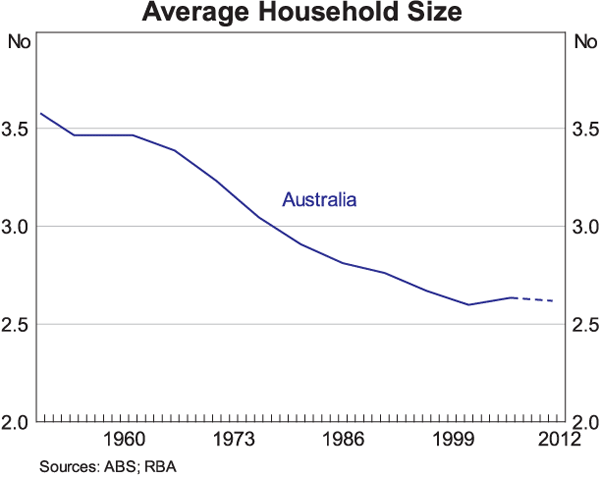
But household size doesn't only reflect demographic preferences, it can also reflect economic factors as well – in particular, the cost of housing (relative to incomes). If housing was less expensive, then young adults may decide to move out of their parents' home earlier, people may decide to live by themselves rather than in a group household, and more people may decide to have a holiday home.
As has been well documented, the price of housing increased strongly relative to incomes in Australia over the 1990s and into the early 2000s. This largely reflected households' greater ability to borrow with the decline in nominal interest rates reducing initial mortgage repayments, as well as deregulation and innovation in the financial sector improving households' access to credit. While the increase in the cost of housing will have tended to reduce the household formation rate, people's greater access to credit is likely to have offset this to some extent as they found it easier to get a loan to purchase a home sooner.
The sharp increase in house prices from 1999 to 2003 is likely to have had a dampening effect on household formation rates, and so the demand for housing. We can get some guide to the relative importance of the cost of housing and demographic factors in the levelling off in average household size by looking at the structure of households. A few effects seem to stand out as important. First, the number of dependent children in families stopped falling as rapidly with some increase in fertility rates; this would not be caused by an increase in house prices. Second, the share of households with two adults living as husband and wife or partners stopped falling; presumably this largely reflects social factors, although house prices could also have been relevant. Third, the decline in the average size of group households levelled off; this is more likely to reflect the increase in the cost of housing. So while we certainly can't be precise, the evidence from household types suggests that demographic factors are clearly important in explaining the average household size levelling off, but that the increase in the cost of housing also seems to have played a role.
It is interesting to note that Australia was not alone in experiencing a long trend decline in average household size followed by a levelling off in more recent decades (Graph 3). While all of the Anglo-Saxon countries in this graph experienced a run-up in house prices around the turn of the century, there were some differences in the magnitude of that increase and the behaviour of house prices over the preceding decade. So while the levelling off in average household size in all of these countries may, in part, be a response to increases in house prices, it would seem likely that similar demographic factors have also played a part.
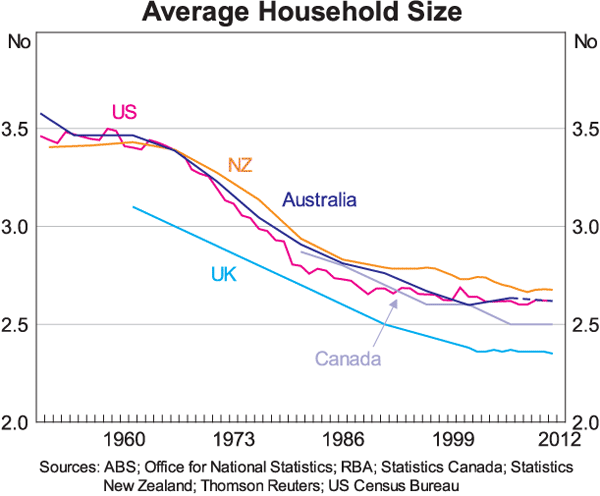
Despite the recent increase in population growth, the levelling off in average household size has meant that the growth in the number of households has been slower since around 2000 than in preceding decades. Often analysts calculate a concept of ‘underlying demand’ which is said to be the demand for new housing there would have been in the absence of significant changes in price growth. It is the demand for new housing resulting from the growth in the population and change in average household size attributable to factors other than the cost of housing. But, as I outlined earlier, it isn't really possible to distinguish what part of the levelling off in average household size is the result of demographic preferences, and how much is due to the cost of housing. Depending on what assumptions are made about this, some basic calculations can suggest that, since 2005, new construction and ‘underlying demand’ have been somewhere between being broadly in balance to there being a shortfall of up to 50,000 dwellings per year.
However, if we think that there has indeed been a relative shortage of supply over the past decade or so, one puzzle is why house prices have been flat or even declined a little (relative to incomes) over this period. One possibility is that, after the large increase in prices in the late 1990s and early 2000s, there has been a gradual reassessment by households of the fundamental value of housing, and their willingness to take on debt to fund housing. If households have indeed lowered the value they place on housing, but prices only adjust slowly – in part because of frictions in the housing market including possibly in supply – this could restrict the rate of new construction. Historically, new construction has typically increased with faster growth in house prices, and so an extended period of weak house price growth could be a factor in the limited increase in the supply of new housing.
Housing Supply
So why might housing supply have fallen short of ‘underlying demand’? One obvious constraint on new construction is the supply of land. Much of the development in cities' inner suburbs is on brownfield sites, such as formerly industrial land, and a larger share of this is higher-density housing. In contrast, new construction in outer suburbs is more likely to be on greenfield sites, that is newly developed land, and a higher share of this is detached housing. So the supply issues in inner and outer suburbs can be somewhat different, and are likely to be different again to those that may affect supply in regional areas. Yet, over the past decade or so, the cycle in housing construction has been broadly similar in all of these different areas, with flat or declining construction up to 2009 in New South Wales and Victoria, before there was some pick-up (that was stronger in Victoria) (Graph 4). So, overall, the cycle of construction in different locations also suggests that demand has been a dominant factor in weak construction over the past decade, or that if there are supply constraints they apply to all types of development and locations.

A couple of months ago, the Bank released an article that discussed the supply-side issues in the housing market that our liaison contacts, and other public reports, have highlighted as being significant.[3] The planning process is typically seen to be complex, and had become more so over time. The number of regulations that developers have needed to comply with increased, and these have often been administered by different agencies that have not always coordinated well.
The provision and funding of infrastructure is also difficult. In the past, governments put in place and funded roads, water and other services, and community infrastructure, paying for these out of general revenue. But, in recent decades, there has been a move toward ‘user-pays’ with the developer often responsible for the provision of much of the new infrastructure and the up-front cost needing to be incorporated in the development stage. Who ultimately pays for this infrastructure will depend on the substitutability between new dwellings and established housing, developers' profit margins and how responsive is the price of undeveloped land.
The ownership of undeveloped land has also been highlighted as an issue in some circumstances. Where the ownership of land on the city fringe is dispersed, say, through many ‘hobby farms’, or equivalently in the inner city where existing blocks could be used for infill, it can be difficult for developers to negotiate the purchase of sufficient land to make development economically viable. Proposed developments can also attract opposition from nearby existing residents. These objections can take many forms including increased congestion, a change in the character of the area, environmental issues or reduced value of their own homes.
Many of these changes, such as greater environmental legislation and user-pays infrastructure, have been implemented for social and economic efficiency reasons, and so may be beneficial overall. But delays and uncertain timing – while infrastructure provision is negotiated, or additional regulations or local concerns are satisfied – are costly for developers. Delays and uncertainty can increase the cost of financing and charges incurred such as rates payments, as well as increasing the required rate of return to compensate for the greater risk.[4]
Governments at state and local levels have responded to these issues in a range of ways. In some states, there have been centralised authorities established to deal with major new residential development proposals. A related initiative has been a simpler approval process for projects that adhere to a set of predetermined standards. There have also been some measures to release more greenfield land and cap infrastructure costs. Industry participants report that these various initiatives are generally having a positive effect, but there remain complex issues and differing views on appropriate responses.
Other Indicators of Housing Balance
Given the difficulties in interpreting housing demand and supply, an alternative, and possibly more direct, way to examine the tightness of housing supply is to look at the rental market.
Some share of properties being vacant is normal as tenants move out and vacancies are advertised. But a high vacancy rate indicates that there are excess dwellings available at the rents being charged, while conversely a low vacancy rate is indicative of a shortage of rental properties. Of course, if there is a relative shortage of rental properties then rents will tend to rise faster than otherwise, and so the rate of increase in rents is another indicator of the strength of demand relative to supply. As this graph shows, there is a fairly close relationship over time between the vacancy rate (on an inverted scale) and the increase in rents after accounting for inflation (Graph 5). The decline in the vacancy rate, and the increase in real rents since the early 2000s, indicate that the rental market has been tightening. For the past seven years or so, real rents have been rising and the vacancy rate has been below its long-run average, suggesting the rental market has been quite tight.
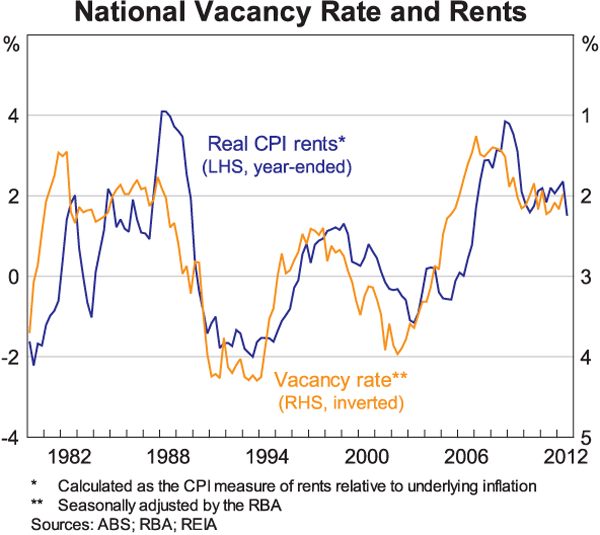
Tightness in the rental market will generally be indicative of tightness in the overall property market. While the typical owner-occupier property will differ to the typical rental property in many ways, there is significant interconnection between the markets for owner-occupier and rental properties. Properties that investors might purchase could otherwise be attractive to first-home buyers, while many households rent while waiting to purchase. Also, for some people, the decision whether to rent or to buy will be influenced by the relative cost and availability of rental properties and properties for sale.
Dwelling Investment
Overall, the information on the strength of demand related to demographic factors, and the tightness in the rental market, suggest that the rate of new construction has been lower than might have been expected. So it seems an expansion of new construction could easily be accommodated by the market. What rate of construction might we then expect to see in the next few years?
The first graph I presented today (Graph 1) showed that over the past 15 years or so the housing stock has grown at a rate a little above 1½ per cent, much lower than the rates of 2–3 per cent in the prior decades. Indeed, despite the growth in population, the number of new dwellings constructed each year has cycled around 100–160 thousand since the early 1970s. Given the growth in economic activity, that would suggest that housing construction has become a smaller share of the economy. But, in fact, new dwelling investment has cycled within a steady range (Graph 6).
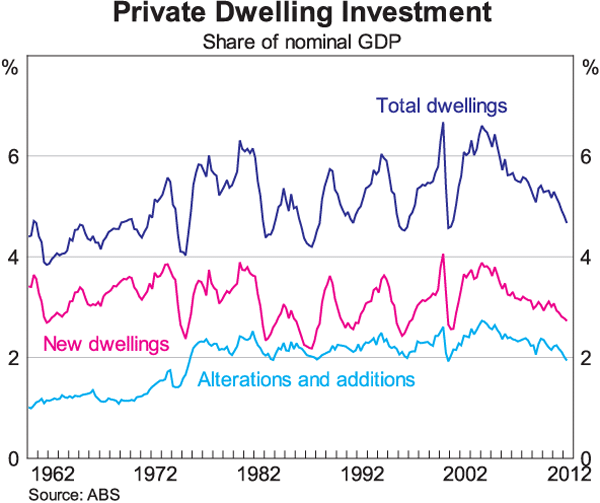
There are two main reasons why dwelling investment has grown in line with the economy while the number of dwellings constructed has remained pretty stagnant.
First, dwellings have become ‘bigger and better’. The average volume of newly constructed dwellings more than doubled from 1960 to 2010, reflecting increases in both the size and quality of new homes (Graph 7). Construction of larger homes, and extensions, have led the share of all homes with four or more bedrooms to increase from 13 per cent in 1970 to around one-third now. New construction also uses higher-quality materials in construction, for example the proportion of houses with brick walls rose from 65 per cent in 1994 to around 80 per cent a bit over a decade later and new dwellings use higher quality fixtures, such as taps and tiles, etc.
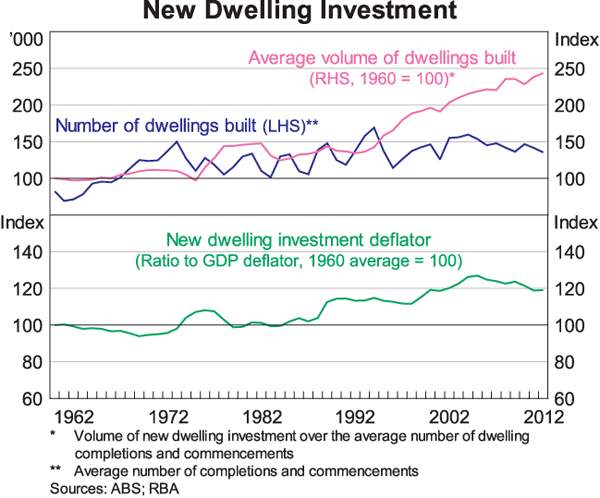
The second contributing factor is that dwelling construction has become comparatively more expensive over time. Since 1970, the cost of dwelling construction has increased by about 25 per cent more than generalised prices in the economy, at least in part reflecting the labour intensity of construction.
So while the number of dwellings constructed each year hasn't grown, the size, quality and relative cost of each dwelling has. The result is that dwelling investment as a share of total economic activity has cycled around a relatively stable level for several decades. It is difficult to say how these trends may change in coming years, with the exception of noting that homes probably won't continue to get bigger. Growth in the size of detached houses slowed recently and there has been a larger share of higher-density dwellings, which tend to be smaller.
The other part of dwelling investment is alterations and additions to existing dwellings. New construction and renovation activity tend to follow very similar cycles, even if the cycle in renovation activity is generally more muted (Graph 8). The factors that drive construction, such as interest rates and house prices, clearly also have a big influence on renovation activity. The increasing average age of the dwelling stock, from a low of 17 years in the early 1980s to around 21 years today, might suggest that renovation activity will increase over time. But other factors, such as the increasing share of higher-density homes, are likely to work in the other direction, dampening renovation activity.
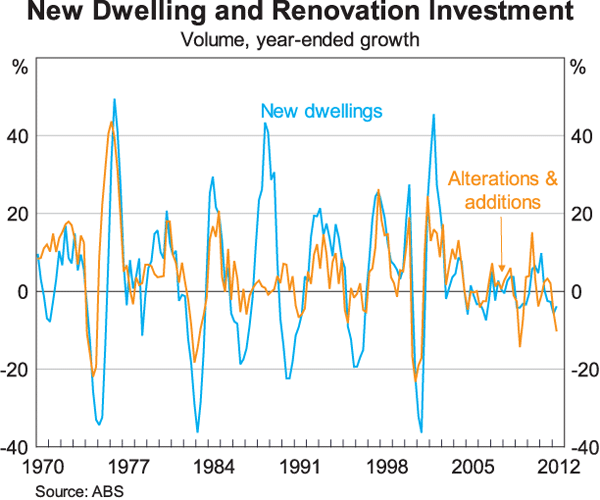
Another notable feature of dwelling investment since around 2003, and in contrast to previous decades, is the absence of a strong cycle. This hasn't only been the absence of a strong upswing, but also that dwelling investment hasn't had the sharp falls over this period that might have been expected, for example, in 2004 when dwelling prices stopped increasing sharply or in the economic downturn in 2009.
In recent years, the share of higher-density dwellings in new construction has increased, and this trend would seem likely to continue. This may have ongoing implications for the nature of the construction cycle given higher-density dwellings take longer from planning, through construction, to completion.
Conclusion
So what is the outlook for dwelling investment? While the long-run decline in the average number of people per household seems to have tapered off at least partly for demographic reasons, the strong population growth in recent years and the relatively low rate of dwelling construction suggest that there is sufficient demand for housing in the economy that an increase in supply could easily be absorbed. The relatively tight conditions in the rental market lead to a similar conclusion. Other factors are also working in favour of an increase in dwelling investment. Interest rates have fallen and income growth has been relatively strong. That said, some factors suggest that the recovery may be relatively modest, including that households have not shown an inclination to take on debt at the same rate they did in the 1990s and early 2000s, and that the ratio of prices to income is high relative to its history, suggesting that it is unlikely that a large increase in prices is in prospect. So, overall, it looks likely that dwelling investment will pick up at a relatively moderate rate in the medium term. How quickly and how strongly of course remain important questions for understanding the impact on the overall economy.
Endnotes
I would like to thank Trent Saunders for his valuable assistance in the preparation of this talk. [*]
If housing is relatively expensive in Australia, then it may be that fewer Australians living abroad, and foreigners eligible for visas or permanent residency, decide to move to Australia because of the cost of living. [1]
The primary source used here for data on population and the number of households is the ABS Australian Demographics Statistics release, extended with information from the Census where needed. The results from the 2011 Census suggested that the resident population was around 300,000 less than previously estimated. This partly reflected a change in the methodology used by the ABS for estimating the net undercount in the Census. The ABS has incorporated this revision in the resident population estimates by distributing it evenly over the five years since the previous Census. This has affected both the population levels and growth rates over this period; however, as advised by the ABS, we have instead estimated population growth using the components of population growth. The resulting growth rates have only been very marginally affected by the incorporation of the new information from the 2011 Census. So the change or growth in demand for housing over the past two decades is little affected by this change in the level of the population. [2]
See Hsieh, Norman and Orsmond (2012). [3]
For a discussion of the potential effect of various frictions in housing supply, see Kulish, Richards and Gillitzer (2011). [4]
References
Hsieh W, D Norman and D Orsmond (2012) ‘Supply-side Issues in the Housing Sector’, RBA Bulletin, September, pp 11–19.
Kulish M, A Richards and C Gillitzer (2011) ‘Urban Structure and Housing Prices: Some Evidence from Australian Cities’, RBA Research Discussion Paper 2011-03.
